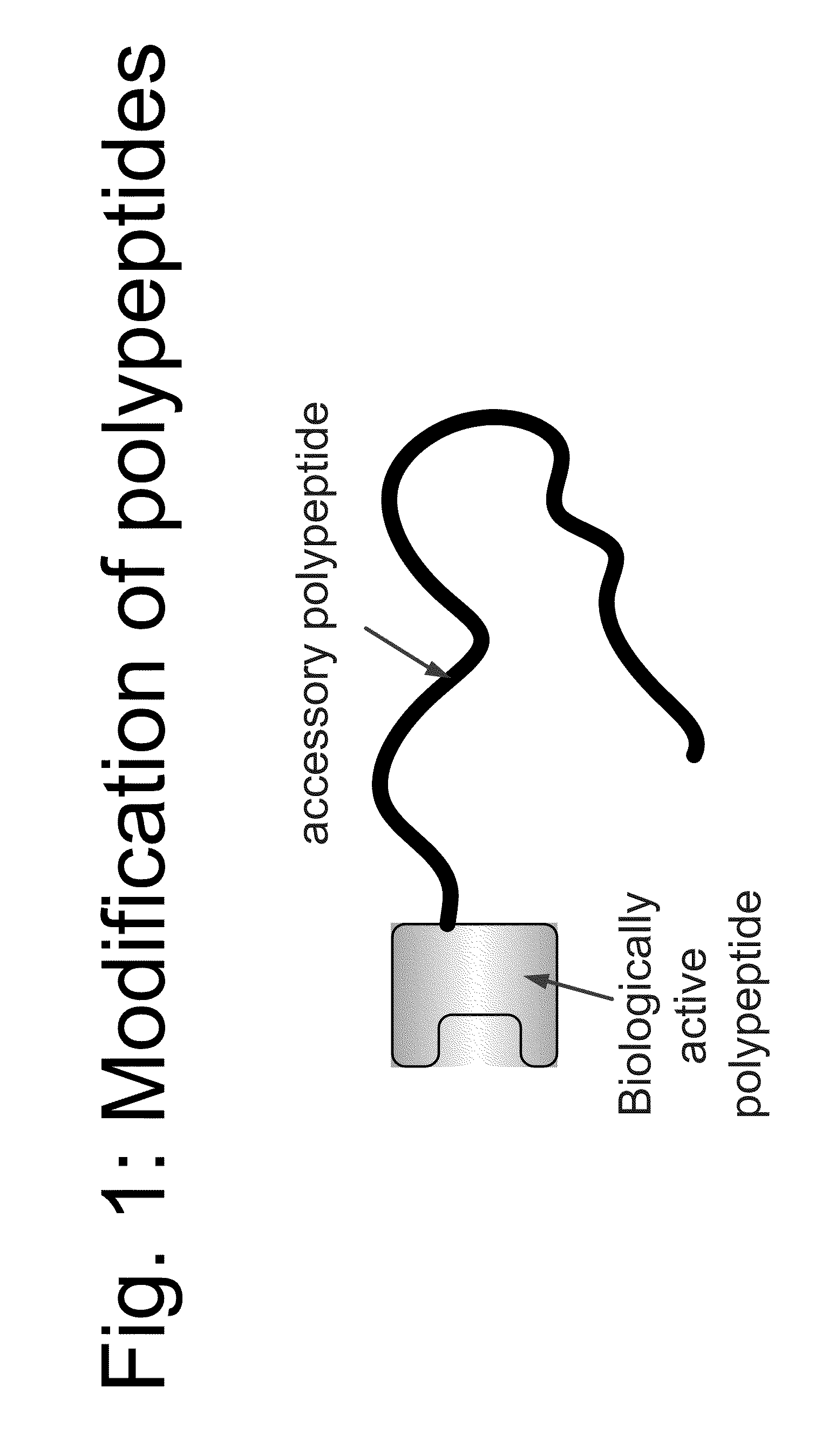Compositions and methods for modifying properties of biologically active polypeptides
a biologically active polypeptide and composition technology, applied in the direction of fusion polypeptides, depsipeptides, peptide/protein ingredients, etc., can solve the problems of patch exposure, inability to provide folding help, and significant optimization of process for protein pharmaceutical production, so as to enhance protein solubility, improve folding, and reduce aggregation
- Summary
- Abstract
- Description
- Claims
- Application Information
AI Technical Summary
Benefits of technology
Problems solved by technology
Method used
Image
Examples
example 1
Design of Human Growth Hormone (hGH) Fused to Accessory Polypeptides
[0680]This example describes the preparation of an rPEG-hGH fusion protein with increased active, cytoplasmic yield and having improved serum half-life. Human growth hormone products typically require daily or twice-daily injections because the halflife of hGH in the serum is only about 30 minutes. Halflife extension through PEGylation is not feasible as hGH contains multiple lysines that are required for therapeutic activity and these cannot be used for conjugation. hGH is typically manufactured by expression in the cytoplasm of E. coli, where it can aggregate and form inclusion bodies containing inactive protein. Typically, these inclusion bodies are solubilized and the protein is refolded to obtain active protein. In this example, rPEG-hGH is expressed in the cytoplasm in soluble and active form, avoiding the step of refolding from inclusion bodies.
[0681]The amino acid sequence of hGH used in this experiment is:
F...
example 2
Expression of Human Growth Hormone (hGH)— Cleavable rPEG-Modified Polypeptide
[0712]This example, as illustrated in FIG. 13, describes the preparation of an rPEG_K288-linked human growth hormone polypeptide having a protease cleavage sequence in between the therapeutic protein and the accessory polypeptide. The accessory polypeptide moiety improves solubility during recombinant expression to the extent that the active protein can be easily isolated in large quantities, whereas the protease cleavage site allows the optional removal of the rPEG by protease digestion. The final protein product is a pure and active hGH.
[0713]A plasmid harboring hGH, N-terminally fused to 288 amino acids of rPEG-K288 and, having the repetitive sequence (GEGGGEGGE)32 and a TEV protease cleavage site (ENLYFQ / X), following the T7 promoter (i.e. T7 promoter-hGH-TEV-rPEG_K288), is transformed into BL21(DE3)-star E. coli strain and is grown as described above. Cells are collected by centrifugation and the cell ...
example 3
Expression of Human Growth Hormone (hGH) Fused to CBD and rPEG_K288
[0714]This example describes the preparation of a CBD-TEV-rPEG_K288-hGH fusion protein. After digestion with TEV protease, and purification, the final protein product is -rPEG_K288-hGH.
[0715]A pET-series vector was constructed with T7 promoter, which expresses a protein containing cellulose binding domain (CBD) at the N-terminus, followed by a Tomato Etch Virus (TEV) protease cleavage site, followed by the hGH coding sequence, and by the rPEG_K288 coding sequence: CBD-TEV-rPEG_K288-hGH. The rPEG_K288 has the repetitive sequence (GEGGGEGGE)32. The CBD sequence used is shown in Swissprot file Q06851 and the purification of CBD fusion proteins is described in Ofir, K. et al. (2005) Proteomics 5:1806. The sequence of the TEV cleavage site is ENLYFQ / X; G was used in the X position. This construct was transformed into BL21(DE3)-star E. coli strain and grown essentially as described above, except that the CBD sequence was i...
PUM
| Property | Measurement | Unit |
|---|---|---|
| Fraction | aaaaa | aaaaa |
| Fraction | aaaaa | aaaaa |
| Time | aaaaa | aaaaa |
Abstract
Description
Claims
Application Information
 Login to View More
Login to View More - R&D
- Intellectual Property
- Life Sciences
- Materials
- Tech Scout
- Unparalleled Data Quality
- Higher Quality Content
- 60% Fewer Hallucinations
Browse by: Latest US Patents, China's latest patents, Technical Efficacy Thesaurus, Application Domain, Technology Topic, Popular Technical Reports.
© 2025 PatSnap. All rights reserved.Legal|Privacy policy|Modern Slavery Act Transparency Statement|Sitemap|About US| Contact US: help@patsnap.com



